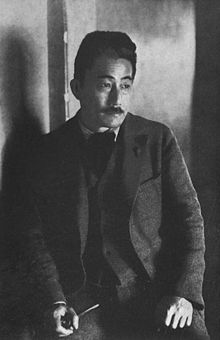| Kaoru Osanai | |
|---|---|
 Kaoru Osanai in 1927 Kaoru Osanai in 1927 | |
| Born | (1881-07-26)July 26, 1881 Naka-ku, Hiroshima, Hiroshima, Japan |
| Died | December 25, 1928(1928-12-25) (aged 47) |
| Nationality | Japanese |
| Occupations |
|
Kaoru Osanai (小山内 薫, Osanai Kaoru, July 26, 1881 – December 25, 1928), was a Japanese theater director, playwright, and actor central in the development of modern Japanese theater.
Biography
Kaoru Osanai was born on July 26, 1881, in Hiroshima, the second son of Director of Hiroshima Army Garrison Hospital, Takeshi Osanai. His father was a former samurai from Hirosaki Domain. When he was five, Takeshi died abruptly at the age of 38, leaving his three children Reiko, Kaoru and Yachiyo to his wife Taka. Osanai subsequently moved to Tokyo where he received his education. The family lived comfortably at Takeshi's mansion where Taka and her female friends practiced music. Osanai studied English literature at Tokyo Imperial University, graduating in 1906.
In 1909, Osanai founded the Free Theater (Jiyū Gekijō) with Ichikawa Sadanji II and staged translations of Ibsen, Chekov, and Gorky, but there he experienced the limits of doing realist theater with kabuki actors. Osanai described these limits as an "existing theatrical poison", for he aimed to extend the boundaries of kabuki as part of the shingeki movement. Osanai was one of the many animators who contributed toward defining the fundamental aspects of shingeki theatre.
His first production with the Free Theater, John Gabriel Borkman, brought Western naturalist and modernist drama which would challenge social conventions. Between December 1912 and August 1913, Osanai traveled throughout Europe to experience modern theater first-hand. He was particularly impressed with the work of the Moscow Art Theatre. After returning to Japan in 1920, he worked as the research director of the Shochiku Cinema before he helped found the Tsukiji Little Theater in 1924 and continued to influence shingeki theater. He also played an important role in film history when he was hired by Shochiku in 1920 to head their actors school. He helped produce and appeared in Souls on the Road, a groundbreaking work in Japanese cinema, and raised such important film talents as Minoru Murata, Kiyohiko Ushihara, Daisuke Itō, Yasujirō Shimazu, and Denmei Suzuki. He also taught at Keio University and helped support such young writers as Jun'ichirō Tanizaki.
The list of plays that were staged in the theatre did not include plays by Kikuchi Kan, Kunio Kishida, and Yūzō Yamamoto.

On December 25, 1928, Osanai collapsed at a Chinese restaurant in Nihonbashi during a thank-you party held after the performance of Fumiko Enchi's first play Banshun Sōya, and died shortly after returning home. The cause of death was cerebral infarction.
References
- Foley, Kathy (2016). "Review of MODERN ASIAN THEATRE AND PERFORMANCE 1900–2000, Kevin J. Wetmore Jr.; THE METHUEN DRAMA ANTHOLOGY OF MODERN ASIAN PLAYS, Siyuan Liu, Kevin J. Wetmore Jr". Asian Theatre Journal. 33 (1): 217–220. doi:10.1353/atj.2016.0011. ISSN 0742-5457. JSTOR 24737166. S2CID 164011855. "Wetmore deals cleanly with Japanese theatre as part of the modernization project Wetmore notes some of the new attempts within the kabuki frame then takes us through the work of seminal figures like Osanai Kaoru, Tsbouchi Shōyo, and so on."
- Tsubouchi, Shōyō; 坪內逍遥 (2002). Tsubouchi Shōyō · Futabatei Shimei shū. Shimei Futabatei, Toshihiro Aoki, Shinsuke Togawa, 二葉亭四迷, 靑木稔弥, 十川信介. Iwanami Shoten. 小山内建. ISBN 4-00-240218-5. OCLC 51555334.
- Osanai, Tomiko; 小山內富子. (2005). Osanai Kaoru : kindai engeki o hiraku (Shohan ed.). Keiō Gijuku Daigaku Shuppankai. pp. 45, 53. ISBN 4-7664-1124-2. OCLC 58429292.
- "Kanpō". Kanpō. 6910. 大蔵省印刷局: 340. July 12, 1906 – via National Diet Library of Japan.
{{cite journal}}: CS1 maint: others (link) - ^ "Kaoru Osanai". Prominent People of Minato City. Retrieved 2 July 2010.
- Brandon, James R.; Goodman, David G (2000). "Japan". The Cambridge Guide to Theatre. Cambridge University Press. p. 566.
- Morinaga, Maki Isaka (2005). "Osanai Kaoru's Dilemma: "Amateurism by Professionals" in Modern Japanese Theatre". TDR 1988. The MIT Press. p. 119.
- Ottaviani, Giovi (1994). ""Difference" and "Reflexivity": Osanai Kaoru and the Shingeki Movement". Asian Theatre Journal. 11 (2): 213–230. doi:10.2307/1124229. JSTOR 1124229.
- Matsumoto, Shinko (1995). "Osanai Kaoru's Views on Russian Theatre". In Rimer, J. Thomas (ed.). A Hidden Fire: Russian and Japanese Cultural Encounters, 1868-1926. Stanford: Stanford University Press. p. 69.
- Constantinidis, Stratos E. (2007). Text & Presentation, 2006. McFarland. p. 177.
- 文芸年鑑 昭和5年版. The Japan Writers' Association (文芸家協会). Shinchosha. 1930. pp. 13–14.
{{cite book}}: CS1 maint: others (link) - Hattori, Toshirō; 服部敏良 (2010). Jiten Yūmeijin no shibō shindan : Kindai hen. Yoshikawa Kōbunkan. p. 80. ISBN 978-4-642-08035-4. OCLC 613313299.
External links
- Osanai Kaoru at Aozora Bunko (in Japanese)
- Kaoru Osanai at IMDb
- Works by or about Kaoru Osanai at the Internet Archive